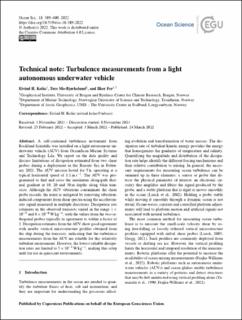| dc.contributor.author | Kolås, Eivind Hugaas | |
| dc.contributor.author | Mo-Bjørkelund, Tore | |
| dc.contributor.author | Fer, Ilker | |
| dc.date.accessioned | 2023-01-31T13:41:01Z | |
| dc.date.available | 2023-01-31T13:41:01Z | |
| dc.date.created | 2022-03-24T12:02:14Z | |
| dc.date.issued | 2022 | |
| dc.identifier.issn | 1812-0784 | |
| dc.identifier.uri | https://hdl.handle.net/11250/3047467 | |
| dc.description.abstract | A self-contained turbulence instrument from Rockland Scientific was installed on a light autonomous underwater vehicle (AUV) from OceanScan Marine Systems and Technology Lda. We report on the data quality and discuss limitations of dissipation estimated from two shear probes during a deployment in the Barents Sea in February 2021. The AUV mission lasted for 5 h, operating at a typical horizontal speed of 1.1 m s−1 . The AUV was programmed to find and cross the maximum along-path thermal gradient at 10, 20 and 30 m depths along 4 km transects. Although the AUV vibrations contaminate the shear probe records, the noise is mitigated by removing vibrationinduced components from shear spectra using the accelerometer signal measured in multiple directions. Dissipation rate estimates in the observed transects varied in the range 1 × 10−8 and 6×10−6 W kg−1 , with the values from the two orthogonal probes typically in agreement to within a factor of 2. Dissipation estimates from the AUV show good agreement with nearby vertical microstructure profiles obtained from the ship during the transects, indicating that the turbulence measurements from the AUV are reliable for this relatively turbulent environment. However, the lowest reliable dissipation rates are limited to 5 × 10−8 W kg−1 , making this setup unfit for use in quiescent environments. | en_US |
| dc.language.iso | eng | en_US |
| dc.publisher | Copernicus Publications | en_US |
| dc.rights | Navngivelse 4.0 Internasjonal | * |
| dc.rights.uri | http://creativecommons.org/licenses/by/4.0/deed.no | * |
| dc.title | Technical note: Turbulence measurements from a light autonomous underwater vehicle | en_US |
| dc.type | Journal article | en_US |
| dc.type | Peer reviewed | en_US |
| dc.description.version | publishedVersion | en_US |
| dc.rights.holder | Copyright 2022 The Author(s) | en_US |
| cristin.ispublished | true | |
| cristin.fulltext | original | |
| cristin.qualitycode | 1 | |
| dc.identifier.doi | 10.5194/os-18-389-2022 | |
| dc.identifier.cristin | 2012246 | |
| dc.source.journal | Ocean Science | en_US |
| dc.source.pagenumber | 389-400 | en_US |
| dc.relation.project | Norges forskningsråd: 276730 | en_US |
| dc.identifier.citation | Ocean Science. 2022, 18 (2), 389-400. | en_US |
| dc.source.volume | 18 | en_US |
| dc.source.issue | 2 | en_US |

